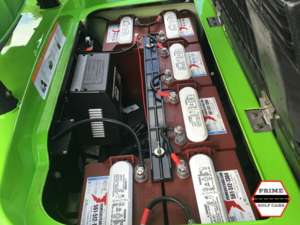As the weather begins to get colder and the golf carts begin to roll into storage, it’s important to know how to maintain your golf cart batteries for the winter season. Juno Beach Golf Cart provides a detailed guide on how to prepare a golf cart for long term storage; today we talk specifically about golf cart battery storage, especially in the winter. The key to maintaining the longevity of lead-acid batteries through the winter is proper storage.
The process of preparing for golf cart battery storage is similar in both the summer and winter seasons, but one thing that remains constant is the importance of fully charging your battery before putting the golf cart into long-term storage. The reason for this is because leaving them discharged in cold weather can actually cause the electrolyte inside to freeze and therefore expand, which could potentially crack the battery case and cause a leak or battery failure. When a battery is not charged, its freezing point is about 20 degrees Fahrenheit, while a fully charged battery has a much lower freezing point: approximately -80 degrees Fahrenheit.
If the weather is not too severe and you’re not putting your golf cart into long-term storage, there are still procedures to follow for using your golf cart in colder temperatures. Cold weather causes the batteries to charge slower, and reduces the battery’s capacity. In this case, it’s extra important to make sure the battery is fully charged before driving the golf cart – a common mistake made is plugging in the battery and assuming it is fully charged, not knowing that charging slows in colder weather, and therefore draining the battery further with every drive. In order to check the charge of your batteries in cold weather, you’ll want to take hydrometer readings of your battery’s cells and use the correction factor of subtracting 0.004 (four points) from your reading for every 10 degrees below 80 degrees Fahrenheit (the optimum temperature to take a hydrometer reading). A fully charged golf cart battery should have a hydrometer reading of approximately 1.270. For example, if the outside temperature is 50 degrees Fahrenheit, and your hydrometer reading returns as 1.200, you’ll want to subtract 0.12 from this reading; your correct reading would therefore be 1.188, which means the battery is less than 50 percent charged. It’s extra important to fully recharge the battery before driving or putting the golf cart into storage, as a golf cart that drops below 50 percent charged can be more difficult to fully recharge.

Another tip we recommend for driving a golf cart in colder weather is using one of our golf cart enclosures – we have a blog detailing the various enclosures we sell for our Advanced EV or Icon® golf carts, available for purchase on our parts website!



